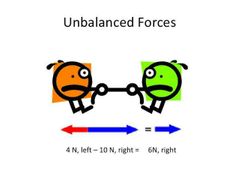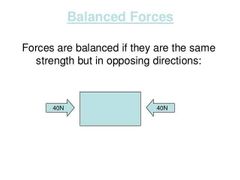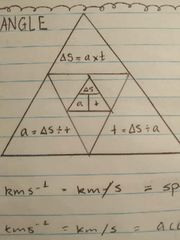![]()
![]()
![]()
Use LEFT and RIGHT arrow keys to navigate between flashcards;
Use UP and DOWN arrow keys to flip the card;
H to show hint;
A reads text to speech;
27 Cards in this Set
- Front
- Back
|
What does N mean in physics? |
N stands for Newtons which is the unit for force. |
|
|
Who is Isaac Newton? |
Isaac Newton is a scientist who became famous because of his discovery called, Newtons laws of motion. |
|
|
What is the formula for force? |
Force = Mass x Acceleration F = M x A |
|
|
What are Newtons laws of motion? |
There are 3 laws that describe the relationship between a body and the forces acting upon it, and the motion in response. Law of Inertia Force = Mass x Acceleration An action will equal a reaction. |
|
|
What is the law of Inertia? |
This is the first law of Newtons las of motion. This is when an object remains at rest or continues to move at a constant velocity, unless acted upon by another force. |
|
|
What is the second law of motion? |
Force = Mass x Acceleration F = ma
|
|
|
What is the third law of motion? |
When one body puts a force on another, the second body will simultaneously exert a force equal in strength and opposite in direction. |
|
|
Unbalanced |

Based on the picture above, the measure of forces ( Newtons ) are unbalanced. This is because there are 4N going left and 10N going right. This means it will go right by 6N. |
|
|
Balanced. |

|
|
|
What is speed? |
Speed is a constant rate. Also called velocity ( v ) |
|
|
What is acceleration? |
Acceleration is having a starting point and gradually increasing speed. |
|
|
What is an equation triangle? |

An equation triangle represents different formulas to show us how to work out problems, using at least two symbols. |
|
|
*triangle* s |
This means a change in speed. |
|
|
a |
Acceleration |
|
|
m |
Mass |
|
|
t |
Time |
|
|
D |
Distance |
|
|
S or V |
Speed or Velocity |
|
|
Si |
Speed Initial / starting speed |
|
|
Sf |
Speed final |
|
|
ms ^-1 |
Used to show a constant speed. |
|
|
ms ^-2 |
Used to show acceleration. |
|
|
Formula for a / acceleration |
a = change in speed / time |
|
|
Formula for t / time |
t = change in speed / acceleration Or t = distance divided by time. |
|
|
Formula for change in speed |
Change in speed = acceleration x time Or Change in speed = Sf - Si (speed final - speed initial) |
|
|
Formula for d / distance |
d = speed x time |
|
|
Formula for s / speed ( v / velocity ) |
V = distance / time |

